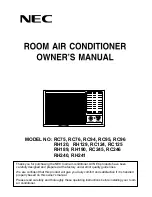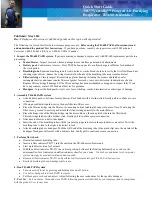
US-ENGLISH
US-ENG- 8
Drill the foregoing holes tilted slightly downwards to prevent water from being fed back through
the ducts (fig. 5).
Most of the removed material is expelled outwards, therefore make sure that it
does not hit any person or object when it falls out. In order to avoid as much
as possible outer plaster breaking, it is necessary to proceed carefully with the
last part of hole execution, decreasing pressure on core borers.
•
Drill the holes, previously marked related to the fixing bracket (fig. 6).
The manufacturer will not be held liable for any underestimates made in the
structural consistency of the anchor prepared by the installer. Therefore, pay
attention to the foregoing operation that could cause serious injury/damage to
people/property if carried out incorrectly.
To properly dispose of condensate the installer must either drill a 5/8” (16mm) hole through the
wall in the position shown on the template or provide means to dispose of the condensate through
the bottom of the unit into a drain or condensate pump.
To avoid frozen lines leading to unit high water alarms, if outdoor temperatures can be expected
to drop below 32ºF (0ºC) for any extended time interval the condensate line should not be installed
through the wall to the outside.
2.4.2 - Preparing the condensate discharge (fig.6-7)
•
A condensation drain line (N) must be inserted into the connection which can be accessed after opening
the door under the unit and connected to the unit. Remove the cap (B) before inserting the condensation
drain pipe . When the max level is reached, a solenoid valve enerizes to allow the condensate to flow
out from the internal tray.
•
For cooling only units a connect line condensate line if the unit will be operated at outdoor temperatures
lower than 74ºF (23ºC).
•
Since condensate drains by gravity, there must be a minimum slope of at least 1/4” (6.4mm) per foot.
Use a rigid or flexible tube having an inside diameter of at least 5/8” (16mm).
•
If the line empties into a sewerage system, install a trap before the point in which the pipe reaches the
main discharge, at least 12” (300mm
) below the inlet from the unit (fig.8).
•
If the condensate line drains into a vessel (tank or other container), this container should not be sealed
and the line should not remain immersed in the water (see fig.9).
•
The hole through which the condensate line passes should always slope towards the outside (see fig.
10). The exact position in which to place the line, as compared to the unit is shown on the template.
Make sure that the water expelled outward does not damage or disturb persons
or property. During winter this type of drainage may cause sheets of ice to form.
Take care not to compress or kink the condensate hose.
Summary of Contents for Maestro Pro Inverter 12 HP
Page 4: ...min 60mm min 80mm 3 2 min 60mm 2 4 min 100mm 2 4 4 2 3...
Page 5: ...M Y 4 5 B N 8mm 3 6 H H 7 6...
Page 6: ...min 300mm 12 8 9 3 4 202 mm G 162 mm 130 mm G 8 6 5 5 1 10 12 11 G G...
Page 7: ...F D F 13 14 6mm 1 4 15 17 16 18 F E E...
Page 8: ...19 20 E 22 A B 21 W...
Page 9: ...23 A B 26 24 25 L 27 H L L...
Page 10: ...28 29 3 3 3a 3a 1 1 1a 1a 1a 1b 1b 1b 1a 1c 32 X3 X4 30 31 X1 X2 X2...
Page 11: ...34 J2 J1 33 J2 J1 35 8m 26 36 37...
Page 12: ...41 40 F F2 F1 F F2 F2 F1 F1 43 3 3 42 F min 80mm 3 2 39 3 F 38 10 7...
Page 13: ...44 45 6 min 5 L 5 qts 6a...
Page 14: ...46 47 48 Y2 Y2 Y3 Y3 Y1...
















































